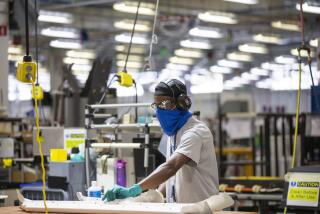Pre-Katrina Survey Likely to Show Growth
- Share via
A report this week is likely to show that construction, mining and services kept the U.S. economy expanding briskly in August, before Hurricane Katrina caused death and destruction in a region that accounts for a third of the nation’s oil production and almost half its grain exports.
Tuesday’s report on the Institute for Supply Management’s survey on the services economy will probably show that business at non-manufacturing companies remained close to this year’s average in August. The group’s non-manufacturing index probably slipped to 60 from 60.5 a month earlier, according to the median forecast in a Bloomberg News survey. Measures greater than 50 signify expansion. The index has averaged 60.7 this year.
Investors will be watching reports on recovery efforts in the Gulf Coast region after Katrina damaged offshore oil platforms and shut refineries, causing record gasoline prices and fuel shortages in parts of the U.S. and prompting economists to lower their economic growth forecasts.
“Higher prices are likely to cause some consumers to stay home to conserve both their funds and the fuel in their tanks,” said John Silvia, chief economist at Wachovia Corp. in Charlotte, N.C.
It’s not likely that the August services report will capture the effects of Katrina, which struck the Gulf Coast on Aug. 29. The Institute for Supply Management sends out its survey during the first week of each month, and responses are received through the end of each month.
As of Sept. 1, Hurricane Katrina had shut down oil production of 1.36 million barrels a day, or 90% of the region’s normal output, according to a report from the Interior Department’s Minerals Management Service in Washington.
Economists at Lehman Bros., Bear, Stearns & Co., Banc of America Securities and Credit Suisse First Boston were among those lowering their forecasts for economic growth last week.
“The key to the indirect effects on growth is the length of the period of higher energy prices,” John Ryding, chief U.S. economist at Bear Stearns in New York, wrote in a research note. “We don’t know how long it will last,” he later said in an interview. “Let’s face it. We have to look at things like how fast energy prices are unfolding.”
Ryding lowered this quarter’s gross domestic product forecast to 3.5% from 4.5%.
The pace was 3.3% in the second quarter and 3.8% in the year’s first three months. The slowdown in the economy in the second quarter, while worker hours were increasing, probably pushed down productivity, economists said.
Productivity, a measure of how much an employee produces for every hour of work, increased at a 2.1% annual rate in the second quarter, according to the median estimate of economists in advance of Wednesday’s Labor Department report. That compares with 2.2% initially reported and 3.2% in the first three months of the year.
“Companies have gotten what they can out of productivity gains,” said Bill Mulvihill, an economist at Claymore Investments in Lisle, Ill. “Productivity will remain strong, but businesses need to add workers.”
The cost to companies of employing workers probably accelerated in the second quarter from a year earlier, the Labor Department’s report may show. Rising compensation costs, which account for two-thirds of goods and services prices, support forecasts that Federal Reserve policymakers will raise interest rates one more time before the end of the year.
The U.S. economy expanded more than 3% at an annual rate in each of the last nine quarters. Before the hurricane, economists expected economic growth to accelerate to 4.1% in the July-September period from 3.3% in the second quarter, according to the median of 66 estimates in a Bloomberg survey.
More to Read
Inside the business of entertainment
The Wide Shot brings you news, analysis and insights on everything from streaming wars to production — and what it all means for the future.
You may occasionally receive promotional content from the Los Angeles Times.










